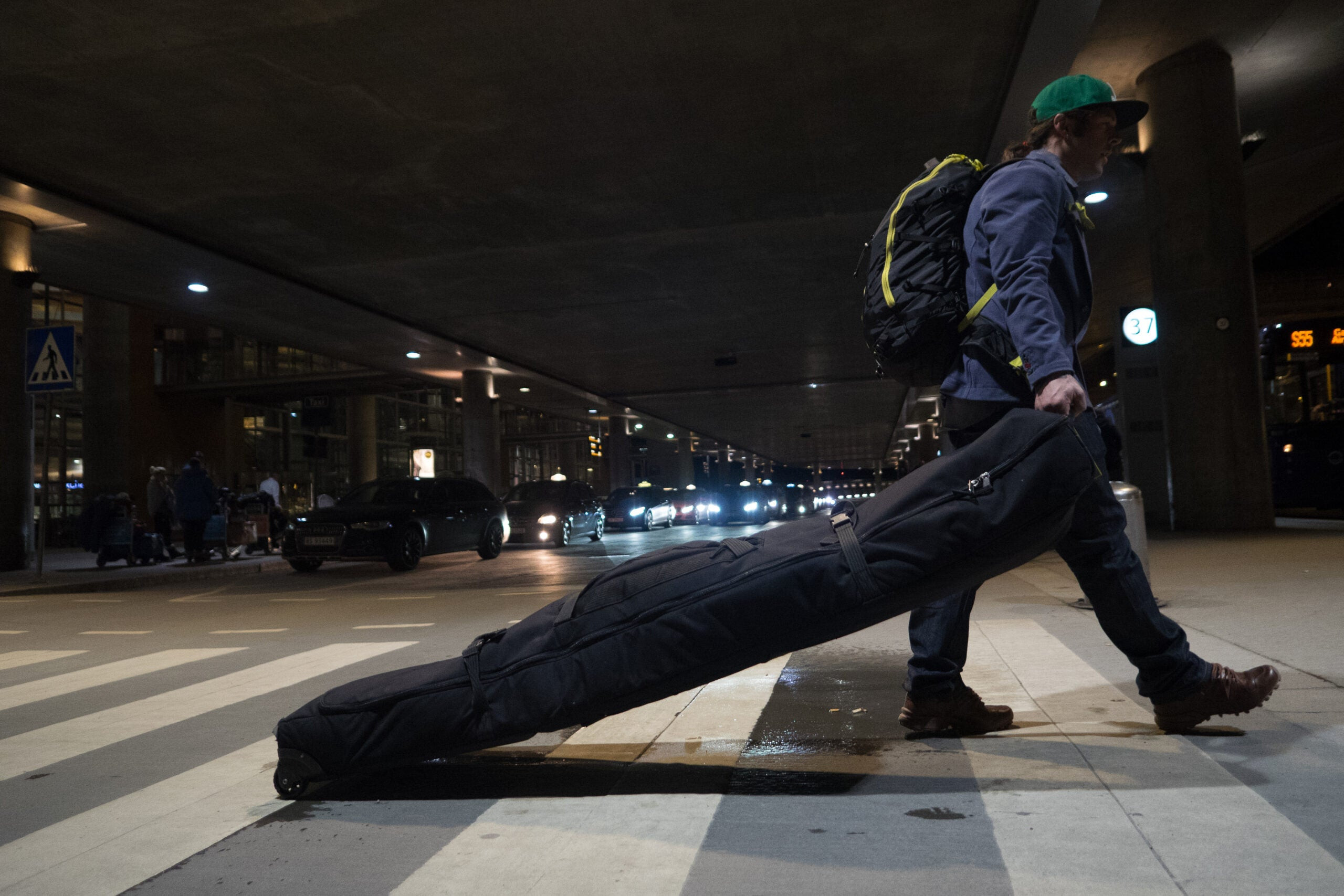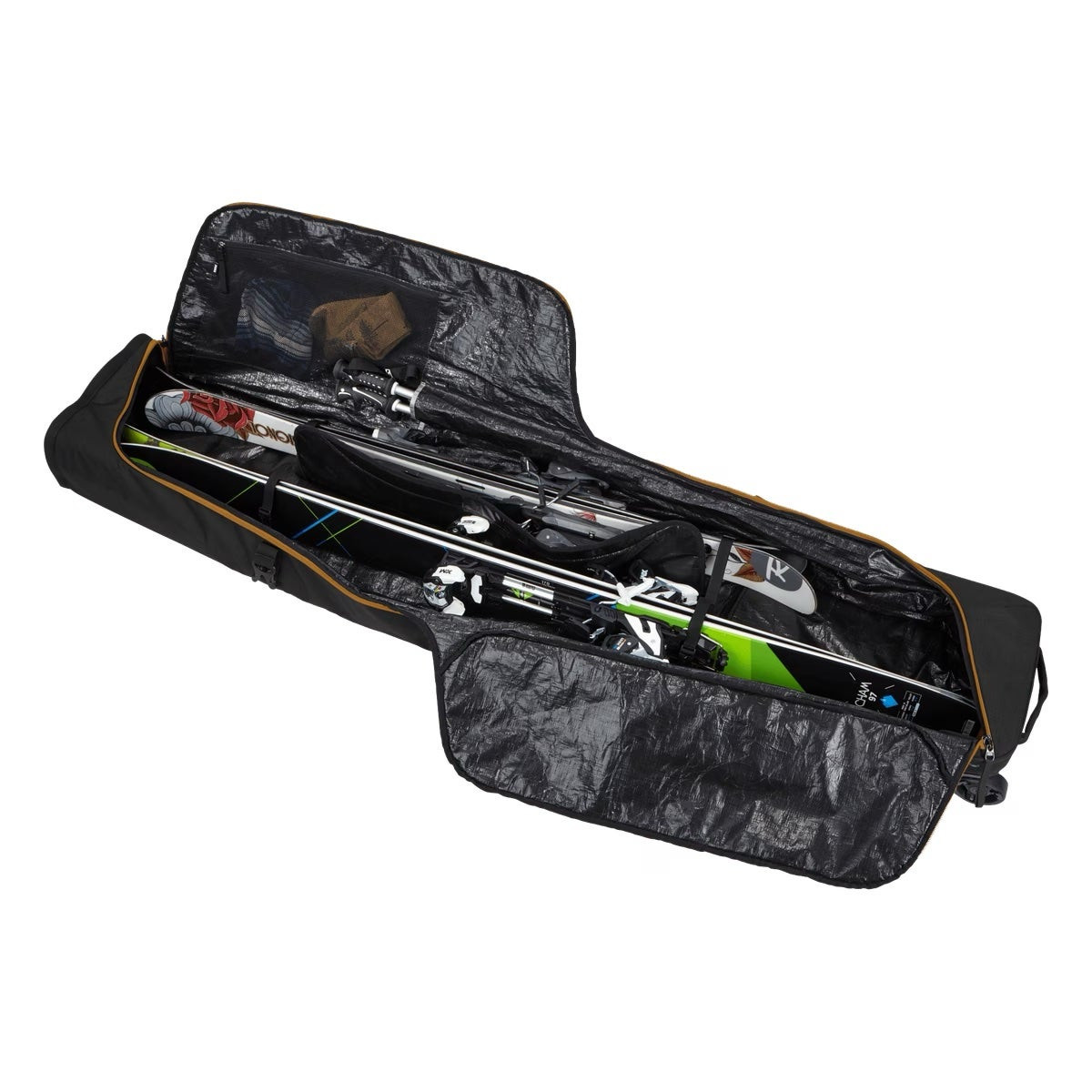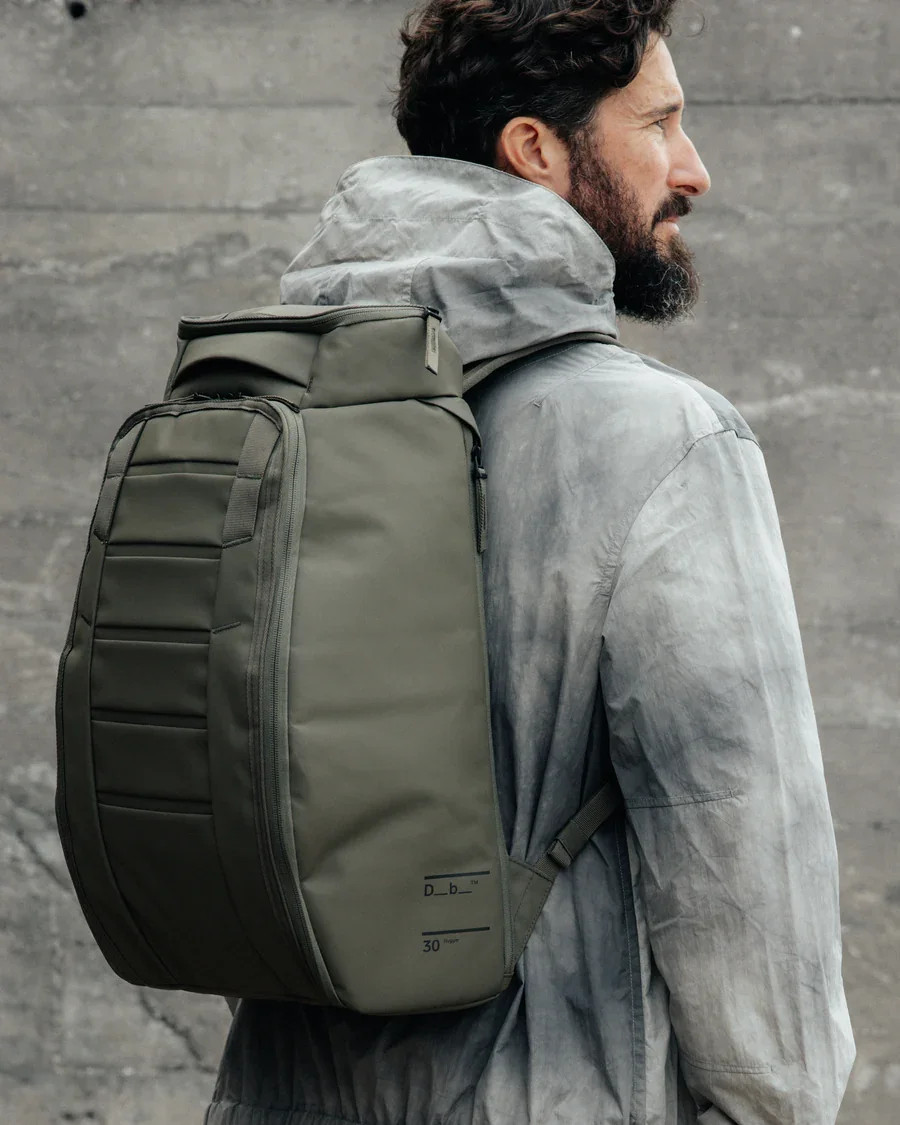Traveling with skis can seem daunting, but with the right preparation, it can be a breeze. At SIXT.VN, we specialize in making your Vietnam travel experience seamless, offering services from airport transfers to hotel bookings. Discover insider tips on how to travel with your skis hassle-free and enjoy your ski trip to Vietnam.
1. Understanding Airline Policies for Ski Travel
Navigating airline policies is the first step in ensuring a smooth journey with your ski equipment. Every airline has specific rules regarding the size, weight, and contents of ski bags, so understanding these can save you time and money.
- Key Takeaway: Different airlines have different policies.
1.1. Major U.S. Airlines: United, American, and Delta
These airlines generally treat a ski bag and a separate boot bag as one checked item. According to their policies, if your reservation includes a free checked bag, you’re all set. If not, you’ll need to pay a checked bag fee, typically between $35 and $40.
- Weight Limit: The combined weight of the ski bag and boot bag must be under 50 pounds (22.7 kg).
- Size Restrictions: Linear dimensions (length + width + height) should not exceed 115 inches (292 cm).
 Skiers Walking with Skis
Skiers Walking with Skis
1.2. Southwest Airlines: A More Generous Option
Southwest offers a more lenient policy, considering a ski bag and boot bag as a single checked bag. This allows you to bring an additional bag for your other travel essentials.
- Free Baggage: One set (ski bag and boot bag) counts as one free checked bag.
- Weight Limit: The 50-pound weight limit still applies.
- Restrictions: Southwest is known for strictly enforcing the “skis and boots only” rule, so avoid over-packing with clothing.
1.3. Budget Carriers: Frontier and Spirit
Budget airlines like Frontier and Spirit have more restrictive policies.
- Frontier: Skis and boots count as one checked bag, but the ski bag must weigh less than 25 pounds (11.3 kg). Overweight bags incur additional fees.
- Spirit: Any bag exceeding 62 inches (157 cm) is charged as oversized.
1.4. International Airlines
When flying internationally, policies vary widely. Airlines like Lufthansa, Emirates, and Air Canada have different rules, weights, and size restrictions. Always check with your specific airline before your trip to avoid surprises.
2. Packing Strategies for Ski Equipment
Efficient packing is essential to protect your gear and maximize space. Here are some strategies for packing your ski equipment safely and effectively.
- Key Takeaway: Proper packing protects your gear.
2.1. Choosing the Right Ski Bag
Selecting the right ski bag is crucial. Options range from single ski bags to double ski bags with extra room for other essentials.
- Single Ski Bags: Suitable for one pair of skis and poles.
- Double Ski Bags: Can accommodate two pairs of skis, poles, helmets, and outerwear.
2.2. Recommended Ski Bags
Several ski bags stand out for their durability, space, and ease of use:
- Db Snow Roller and Snow Roller Pro: These bags can hold two pairs of skis and extra gear, with the Pro version also accommodating ski boots.
- Thule RoundTrip: A double ski bag with wheels and a removable boot bag.
- Dakine Fall Line Roller: Offers room for two pairs of skis and poles, plus a removable boot bag.
- Evo Deluxe Snow Roller: A budget-friendly option that fits two pairs of skis.
 Thule Road Trip Ski Bag
Thule Road Trip Ski Bag
2.3. Protecting Your Gear
Padding your skis and boots is vital to prevent damage during transit.
- Padding Materials: Use ski wear like jackets, pants, and sweaters to cushion your skis.
- Edge Protection: Place long socks over the ski tips to prevent dulling.
- Binding Brakes: Secure binding brakes with thick rubber bands to prevent them from sticking out.
2.4. Additional Packing Tips
- Clothing as Padding: Use soft clothing items to fill empty spaces and provide extra cushioning.
- Organize Small Items: Store gloves, hats, and socks in smaller bags to keep them organized within the larger ski bag.
3. Luggage Restrictions and Weight Limits
Staying within airline luggage restrictions and weight limits is crucial to avoid extra fees.
- Key Takeaway: Adhere to weight limits to avoid fees.
3.1. Understanding Weight Limits
Most airlines have a 50-pound (22.7 kg) weight limit for checked bags, including ski bags. Exceeding this limit can result in hefty overweight baggage fees.
- Weigh Your Bags: Use a luggage scale to weigh your ski bag and boot bag before heading to the airport.
- Distribute Weight: If your bag is overweight, redistribute items between your ski bag, boot bag, and carry-on luggage.
3.2. What to Do If Your Bag Is Overweight
If your ski bag exceeds the weight limit, you have several options:
- Remove Items: Take out heavier items and wear them or place them in your carry-on.
- Ship Items: Consider shipping some items to your destination ahead of time.
- Pay Overweight Fee: If necessary, pay the overweight baggage fee, but be aware that this can be expensive.
3.3. Size Restrictions
Airlines also impose size restrictions on checked bags. The linear dimensions (length + width + height) of your ski bag should not exceed the airline’s specified limit, typically around 115 inches (292 cm).
- Measure Your Bag: Measure your ski bag to ensure it meets the airline’s size requirements.
- Choose the Right Bag: Select a ski bag that fits within the airline’s size restrictions.
4. Carry-On Options for Ski Gear
While skis themselves cannot be carried on, certain ski gear items can be brought on board.
- Key Takeaway: Carry-on options help minimize risk of loss.
4.1. Ski Boots
Consider carrying your ski boots onto the plane, as they are essential for skiing. If your boots get lost, it can significantly impact your ski trip.
- Boot Bags: Use a compact boot bag that meets carry-on size requirements.
- Recommended Boot Bags:
- Kulkea Kartta Travel Boot Bag: Features a laptop sleeve, helmet sling, and space for clothing essentials.
- Db Hugger Backpack: Includes a laptop sleeve and ribcage technology for content protection.
 Db Hugger Boot Bag
Db Hugger Boot Bag
4.2. Other Carry-On Items
- Helmet and Goggles: These can be packed in your carry-on to protect them from damage.
- Essential Clothing: Bring a set of ski apparel in your carry-on in case your checked bags are delayed.
5. Minimizing the Risk of Lost or Damaged Skis
Taking steps to minimize the risk of lost or damaged skis can save you significant stress and hassle.
- Key Takeaway: Preparation reduces risk.
5.1. Labeling Your Bags
Clearly label your ski bag and boot bag with your name, address, phone number, and email address.
- Internal and External Labels: Place labels both inside and outside the bag.
- Use Durable Tags: Opt for durable luggage tags that won’t easily tear off.
5.2. Tracking Devices
Consider using tracking devices like Apple AirTags to monitor your bags’ location.
- AirTags: Place an AirTag inside your ski bag to track its whereabouts using the Find My app.
- Benefits: Provides reassurance and helps locate lost bags quickly.
 Apple AirTag
Apple AirTag
5.3. Travel Insurance
Purchase travel insurance that covers lost or damaged luggage.
- Coverage: Ensure the policy covers the value of your ski equipment.
- Documentation: Keep receipts and photos of your gear for insurance claims.
5.4. Direct Flights
Opt for direct flights to minimize the chances of your luggage being misplaced during transfers.
- Fewer Connections: Reduces the risk of lost luggage.
- Time Savings: Simplifies your travel experience.
6. Ground Transportation Considerations
Planning your ground transportation is an essential part of traveling with skis. Standard cabs or compact rental cars may not be suitable for oversized ski bags.
- Key Takeaway: Plan for oversized luggage.
6.1. Airport Transfers
At SIXT.VN, we offer reliable airport transfer services that can accommodate your ski equipment.
- Pre-Book Transfers: Reserve your airport transfer in advance to ensure a vehicle that can handle your ski bags.
- Specify Your Needs: Inform us about your ski equipment when booking so we can provide the appropriate vehicle.
6.2. Rental Cars
If renting a car, choose a full-sized SUV to accommodate your ski bags comfortably.
- Vehicle Size: Ensure the rental car has enough space for your ski bag and other luggage.
- Dimensions: Consider the dimensions of your ski bag when selecting a rental car.
6.3. Ride-Sharing Services
When using ride-sharing services like Uber, opt for UberXL or similar options that provide larger vehicles.
- Request a Large Vehicle: Specify that you need a vehicle that can accommodate oversized luggage.
- Communicate with Driver: Contact the driver to confirm they can accommodate your ski bags.
7. Alternative Options: Renting Skis at Your Destination
Renting skis at your destination can be a convenient alternative to traveling with your own gear.
- Key Takeaway: Renting is a convenient option.
7.1. Benefits of Renting
- Convenience: Avoid the hassle of transporting ski equipment.
- Cost Savings: Eliminate baggage fees and potential damage costs.
- Try New Gear: Opportunity to test different ski models.
7.2. High-Performance Demos
Many ski resorts offer high-performance demo skis for rent, allowing you to experience the latest equipment.
- Expert Advice: Rental shops can provide expert advice on selecting the right skis for your skill level and the current conditions.
- Well-Maintained Gear: Rental skis are typically well-maintained and tuned for optimal performance.
7.3. Where to Rent
- Resort Rental Shops: Conveniently located at the base of the ski resort.
- Local Ski Shops: Offer a wider selection and competitive pricing.
8. Addressing Common Concerns and Challenges
Traveling with skis can present various challenges. Here’s how to address some common concerns:
- Key Takeaway: Problem-solving ensures a smooth trip.
8.1. Language Barriers
Navigating a foreign country can be challenging due to language barriers. SIXT.VN offers services to help you overcome this.
- Multilingual Support: Our team provides support in multiple languages to assist you with bookings and inquiries.
- Translation Apps: Use translation apps to communicate with locals.
8.2. Cultural Differences
Understanding and respecting local customs is essential when traveling.
- Research Local Customs: Learn about Vietnamese customs and etiquette before your trip.
- Respectful Behavior: Be mindful of local traditions and practices.
8.3. Finding Reliable Services
SIXT.VN ensures you have access to reliable and high-quality travel services.
- Trusted Partnerships: We work with trusted hotels, transportation providers, and tour operators.
- Customer Reviews: Read reviews from other travelers to find reputable services.
9. The Benefits of Using SIXT.VN for Your Vietnam Ski Trip
Choosing SIXT.VN for your Vietnam ski trip offers numerous advantages, ensuring a smooth and enjoyable experience.
- Key Takeaway: SIXT.VN simplifies your travel.
9.1. Comprehensive Travel Services
We provide a wide range of services to meet all your travel needs.
- Airport Transfers: Reliable and comfortable airport transfer services.
- Hotel Bookings: Assistance with finding and booking suitable accommodations.
- Tour Packages: Curated tour packages to explore the best of Vietnam.
- Flight Bookings: Assistance with booking flights at competitive prices.
9.2. Convenience and Reliability
Our services are designed to be convenient and reliable, saving you time and stress.
- Easy Booking: Our online platform makes it easy to book services.
- 24/7 Support: We offer 24/7 customer support to assist you with any issues.
9.3. Personalized Itineraries
We can create personalized itineraries to match your interests and preferences.
- Tailored Experiences: Customized itineraries to explore Vietnam’s unique attractions.
- Expert Advice: Our travel experts provide valuable insights and recommendations.
9.4. Addressing Customer Challenges
We understand the challenges travelers face and offer solutions to overcome them.
- Language Support: Multilingual support to assist with communication.
- Cultural Insights: Information on local customs and etiquette.
- Reliable Services: Trusted partnerships with reputable providers.
10. Creating an Itinerary for a Ski Trip in Vietnam
Planning an itinerary for a ski trip in Vietnam requires considering the climate, available resorts, and other activities.
- Key Takeaway: Plan your trip for optimal experience.
10.1. Best Time to Visit
The best time for skiing in Vietnam is during the winter months, from December to March.
- Optimal Conditions: Coldest temperatures and best snow conditions.
- Peak Season: Expect higher prices and more crowds during peak season.
10.2. Popular Ski Destinations in Vietnam
While Vietnam is not traditionally known for skiing, there are emerging destinations and nearby options.
- Sapa: Known for its stunning landscapes and potential for winter sports.
- Moc Chau: Offers beautiful scenery and opportunities for winter activities.
10.3. Sample Itinerary
- Day 1: Arrive in Hanoi, transfer to Sapa.
- Day 2: Explore Sapa, visit Fansipan peak.
- Day 3: Enjoy winter activities in Sapa.
- Day 4: Return to Hanoi, explore the city.
- Day 5: Depart from Hanoi.
10.4. Activities Beyond Skiing
Vietnam offers a wide range of activities to complement your ski trip.
- Hanoi City Tour: Explore the historic capital city.
- Ha Long Bay Cruise: Visit the stunning Ha Long Bay.
- Cultural Experiences: Discover local customs and cuisine.
11. Essential Tips for a Smooth Ski Trip
Follow these tips to ensure a smooth and enjoyable ski trip to Vietnam.
- Key Takeaway: Preparation is key to enjoyment.
11.1. Pack Appropriately
Pack essential ski gear, warm clothing, and necessary travel documents.
- Ski Apparel: Bring waterproof and insulated clothing.
- Travel Documents: Ensure you have your passport, visa, and flight tickets.
11.2. Stay Connected
Purchase a local SIM card or use international roaming to stay connected.
- SIM Card: Buy a local SIM card for affordable data and calls.
- Wi-Fi: Take advantage of free Wi-Fi at hotels and cafes.
11.3. Learn Basic Phrases
Learning a few basic Vietnamese phrases can enhance your interactions with locals.
- Greetings: Learn how to say hello, goodbye, and thank you.
- Basic Requests: Know how to ask for directions or order food.
11.4. Respect Local Customs
Be mindful of Vietnamese customs and etiquette.
- Dress Code: Dress modestly when visiting religious sites.
- Public Behavior: Avoid loud or disruptive behavior in public places.
11.5. Stay Informed
Keep up-to-date with the latest travel advisories and news.
- Weather Forecasts: Check the weather forecast before heading out.
- Local News: Stay informed about any local events or issues.
12. Maximizing Your Travel Budget
Traveling on a budget requires careful planning and smart choices. Here’s how to maximize your travel budget for a ski trip in Vietnam.
- Key Takeaway: Smart planning saves money.
12.1. Travel During the Off-Season
Consider traveling during the shoulder seasons (November and April) for lower prices and fewer crowds.
- Lower Prices: Accommodation and flights are typically cheaper.
- Fewer Crowds: Enjoy a more relaxed travel experience.
12.2. Book in Advance
Book flights, accommodation, and tours in advance to secure the best deals.
- Early Bird Discounts: Many hotels and airlines offer discounts for early bookings.
- Flexible Dates: Be flexible with your travel dates to find the cheapest options.
12.3. Utilize Public Transportation
Use public transportation to save on transportation costs.
- Buses: Affordable and convenient for traveling between cities.
- Trains: Scenic and comfortable way to travel long distances.
12.4. Eat Local Cuisine
Dine at local restaurants and street food stalls for authentic and affordable meals.
- Street Food: Sample delicious and inexpensive Vietnamese street food.
- Local Restaurants: Look for restaurants frequented by locals for the best value.
12.5. Free Activities
Take advantage of free activities and attractions.
- Parks and Gardens: Explore public parks and gardens.
- Walking Tours: Join free walking tours of cities.
13. Ensuring Safety and Well-being
Your safety and well-being are paramount when traveling. Here’s how to ensure a safe and healthy ski trip to Vietnam.
- Key Takeaway: Prioritize safety and health.
13.1. Health Precautions
Consult your doctor about necessary vaccinations and health precautions.
- Vaccinations: Ensure you are up-to-date on recommended vaccinations.
- Travel Health Kit: Pack a travel health kit with essential medications and supplies.
13.2. Travel Insurance
Purchase comprehensive travel insurance that covers medical emergencies, trip cancellations, and lost luggage.
- Medical Coverage: Ensure your policy covers medical expenses and hospitalization.
- Emergency Assistance: Look for a policy that provides 24/7 emergency assistance.
13.3. Stay Hydrated
Drink plenty of water to stay hydrated, especially in warm climates.
- Carry Water: Carry a reusable water bottle and refill it throughout the day.
- Avoid Dehydration: Limit your consumption of alcohol and caffeine.
13.4. Food Safety
Practice food safety to avoid foodborne illnesses.
- Wash Hands: Wash your hands thoroughly before meals.
- Safe Food Choices: Choose food from reputable sources and avoid raw or undercooked items.
13.5. Personal Safety
Take precautions to protect yourself from theft and scams.
- Secure Belongings: Keep your valuables in a secure place.
- Be Aware of Surroundings: Stay alert and aware of your surroundings.
14. Capturing Memories: Photography Tips
Capture the beauty of your ski trip with these photography tips.
- Key Takeaway: Document your journey beautifully.
14.1. Best Times for Photography
Take advantage of the golden hours (early morning and late afternoon) for the best lighting.
- Golden Hour: Soft, warm light that enhances colors and textures.
- Avoid Midday Sun: Harsh midday sun can create shadows and wash out colors.
14.2. Essential Gear
Bring a good camera, lenses, and accessories.
- Camera: A DSLR or mirrorless camera offers the best image quality.
- Lenses: A wide-angle lens is great for landscapes, while a telephoto lens is useful for wildlife.
14.3. Composition Techniques
Use composition techniques to create visually appealing photos.
- Rule of Thirds: Place key elements along the lines or at the intersections of a 3×3 grid.
- Leading Lines: Use lines to draw the viewer’s eye into the photo.
14.4. Capture Local Culture
Photograph local people, markets, and cultural events.
- Respectful Photography: Ask for permission before photographing people.
- Candid Shots: Capture candid moments to tell a story.
14.5. Experiment with Perspectives
Try different angles and perspectives to create unique photos.
- Low Angle: Shoot from a low angle to make subjects appear larger and more imposing.
- High Angle: Shoot from a high angle to show the scale of a landscape.
15. Sustainable Travel Practices
Practice sustainable travel to minimize your environmental impact and support local communities.
- Key Takeaway: Travel responsibly.
15.1. Reduce Your Carbon Footprint
Choose eco-friendly transportation options and reduce your consumption of resources.
- Public Transportation: Use public transportation instead of taxis or rental cars.
- Reduce Waste: Minimize your use of single-use plastics.
15.2. Support Local Businesses
Shop at local markets, eat at local restaurants, and stay at locally-owned accommodations.
- Boost Local Economy: Support local businesses and communities.
- Authentic Experiences: Enjoy authentic cultural experiences.
15.3. Respect the Environment
Avoid littering, stay on marked trails, and respect wildlife.
- Leave No Trace: Pack out everything you pack in.
- Protect Wildlife: Avoid disturbing wildlife or their habitats.
15.4. Conserve Water and Energy
Conserve water and energy at your accommodations.
- Short Showers: Take short showers to save water.
- Turn Off Lights: Turn off lights and air conditioning when you leave your room.
15.5. Educate Yourself
Learn about the local environment and culture to better understand and appreciate your destination.
- Read Guidebooks: Learn about the local history, culture, and environment.
- Talk to Locals: Engage with locals to gain insights and perspectives.
By following these guidelines, you can make your ski trip to Vietnam an unforgettable experience, filled with adventure, culture, and natural beauty. SIXT.VN is here to help you every step of the way, ensuring your journey is seamless and enjoyable. Contact us today to start planning your dream ski vacation.
Address: 260 Cau Giay, Hanoi, Vietnam
Hotline/Whatsapp: +84 986 244 358
Website: SIXT.VN
FAQ: Traveling With Skis
1. What is the best way to pack skis for air travel?
The best way to pack skis for air travel is to use a padded ski bag, protect the tips and edges, and utilize clothing for extra padding.
2. Can I bring my ski boots on a plane?
Yes, you can bring your ski boots on a plane, either as a carry-on or in a separate boot bag as part of your checked baggage allowance.
3. How much does it cost to fly with skis?
The cost to fly with skis varies by airline but typically falls within standard checked baggage fees, ranging from $35 to $40, provided the ski bag and boot bag combined are under 50 pounds.
4. What are the weight restrictions for ski bags?
Weight restrictions for ski bags are generally 50 pounds (22.7 kg), and exceeding this limit can result in overweight baggage fees.
5. Which airlines offer free ski baggage?
Southwest Airlines offers a more generous policy, considering a ski bag and boot bag as a single checked bag, allowing you one free checked bag.
6. How can I protect my skis from damage during air travel?
To protect your skis from damage during air travel, use padding materials like ski wear, place socks over the ski tips, and secure binding brakes with rubber bands.
7. What should I do if my ski bag is overweight?
If your ski bag is overweight, remove items and place them in your carry-on or consider shipping items to your destination ahead of time.
8. Is it better to rent skis at my destination or bring my own?
Renting skis at your destination can be more convenient, saving you baggage fees and potential damage costs, while bringing your own ensures you ski on familiar equipment.
9. Can I carry ski poles on a plane?
Ski poles must be packed in your checked baggage and cannot be carried onto the plane.
10. What travel insurance should I consider for my ski trip?
Consider purchasing travel insurance that covers lost or damaged luggage, medical emergencies, and trip cancellations to protect your investment and ensure a worry-free trip.



